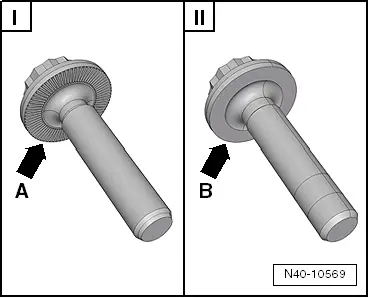Leon Mk1
| Drive shaft with constant velocity joint VL 107 (with intermediate shaft): Assembly overview |

| 1 - | Outer constant velocity joint |
| q | Always replace completely |
| q | Removing → Fig. |
| q | Installation: insert into the complete half-shaft as far as possible by hitting with a plastic hammer. |
| q | check → Chapter |
| 2 - | Bolt. |
| q | Replace after each removal |
| q | Hexagon bolt = 200 Nm + 180° further |
| q | Loosening and tightening the hex bolt → Chapter |
 WARNING
WARNING
|
| 3 - | Clamp |
| q | Replace after each removal |
| q | Tension → Fig. |
| 4 - | Dust boot |
| q | Ensure that there is no damage or cracks from friction |
| q | Material: → Hytrel (polyelastomer) |
| 5 - | Clamp |
| q | Replace after each removal |
| q | Tension → Fig. |
| 6 - | Dished spring |
| q | Installation position → Fig. |
| 7 - | Thrust washer |
| q | Installation position → Fig. |
| 8 - | Circlip |
| q | Replace after each removal |
| q | Fit into the groove on the complete half-shaft |
| 9 - | Dustguard for constant velocity joint |
| q | Material: → Hytrel (polyelastomer) |
| q | Without breather hole |
| q | Ensure that there is no damage or cracks from friction |
| q | Separate from the constant velocity joint using an awl |
| q | Apply lubricating grease → Parts catalogue to the sealing surface before connecting the dustguard to the constant velocity joint |
| 10 - | Dished spring |
| q | Installation position → Fig. |
| 11 - | Clamp |
| q | Replace after each removal |
| q | Tension → Fig. |
| 12 - | Drive shaft |
| 13 - | Intermediate shaft |
| q | Right side of vehicle |
| q | removing and installing → Chapter |
| q | Repairs → Chapter |
| 14 - | Panel |
| q | Replace after each removal |
| q | Always replace |
| q | Pressing off → Fig. |
| 15 - | Circlip |
| q | Insert and remove using pliers -VW 161 A- |
| 16 - | Seal |
| q | The surface that is attached to the constant velocity joint should be free of grease and oil |
| 17 - | Inner constant velocity joint |
| q | Always replace completely |
| q | Pressing off → Fig. |
| q | Pressing on → Fig. |
| q | check → Chapter |
| 18 - | Panel |
| q | Drive off carefully with drift |
| q | Apply lubricating grease → Parts catalogue to the sealing surface before connecting the dustguard to the constant velocity joint |
| q | Adhesive surface must be free of oil and grease! |
| 19 - | Locking plate |
| 20 - | Multi-point socket head bolt |
| q | Initially tighten diagonally to 10 Nm and then tighten diagonally to specified torque. |
| M8 bolt: 40 Nm |
| M10 bolt: 70 Nm |
| q | Always replace bolts after dismounting |
| 21 - | Clamp |
| q | Replace after each removal |
| q | Tension → Fig. |
| 22 - | Hexagonal bolt |
| q | 20 Nm |
| 23 - | Countersunk head bolt |
| q | Initially tighten to 5 Nm and then to 35 Nm |
| q | 3 off |
| 24 - | Mounting bracket |
| 25 - | Support |
| q | Pressing off and on → Chapter |

